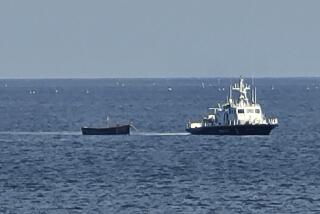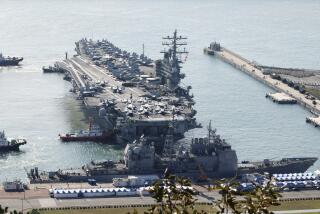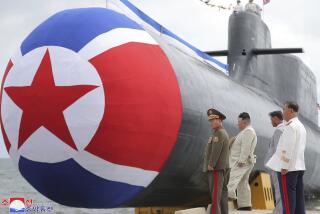James Bond theories arise in Korean ship sinking
- Share via
Reporting from Seoul — The image is chilling: A submersible suicide bomber set loose by North Korea destroys a South Korean warship and kills at least 40 crew members.
Each day, the mystery over the fate of the 1,200-ton patrol boat Cheonan deepens — with the speculation taking on what some analysts say is a fantastic, James Bond quality. The Cheonan split in two and sank March 26 on a mission at the disputed sea border between North and South.
The Korean peninsula is always tense, but the specter of war has increased in recent weeks as investigators point to possible North Korean involvement in the sinking, suggesting the Cheonan was struck by either a floating mine or enemy torpedo.
North Korea has denied responsibility, but South Korean President Lee Myung-bak is under pressure to respond with force if Pyongyang is found to be the culprit.
As salvagers over the weekend raised the bow section of the ship, a team of civilian and military investigators probing the mishap blamed a “non-contact external explosion” beneath the warship rather than a direct hit.
Quoting unnamed naval sources, South Korea’s largest newspaper recently published claims that the attack was carried out by a specially trained team of “human torpedoes” in retaliation for a November sea battle that reportedly killed at least one North Korean sailor.
Additionally, at least one North Korean defector and an activist in Seoul have provided details of the elite unit of 13 commandos in mini-submarines, according to the newspaper Chosun Ilbo.
The activist, Choi Sung-yong, head of a group that seeks the return of abductees taken by the North, said in an interview that he was told of the program by a major in a North Korean special-forces unit.
He said he contacted the major about the remains of his father, who had allegedly been kidnapped years ago by North Korea, and he mentioned the Cheonan disaster.
Choi said that in an April 15 telephone conversation he taped, the major said North Korea had developed an elite mini-submersible commando team. He quoted the North Korean major as saying he had not heard of the sinking of the Cheonan, but suggesting that the North was responsible, using “a new weapon that had fired one shot.”
The major did not specifically say the Cheonan was hit by a “human torpedo.” Choi said North Korean leader Kim Jong Il visited naval commanders after the November skirmish and said the country must retaliate.
The North Korean defector, Jang Jin-sung, who once worked within Pyongyang’s spy network, said he is also convinced the Cheonan was hit by a so-called human torpedo.
Jang said that he saw the program firsthand as a veteran of the North’s ministry in charge of espionage operations, before defecting in 2004.
The human torpedo units “are treated better than the submarine crew and their training focuses on suicide bombing attacks,” Jang wrote on his blog.
“The first thing Kim Jong Il sees when inspecting the Navy Command is the suicide bombing training of soldiers in this unit,” he wrote.
Chosun Ilbo said in addition to suicide bombing tactics, North Korean crews also launch attacks using semi-submersible vessels equipped with light torpedoes or other explosives, which are fired or placed on their targets at close range.
This month, a South Korean lawmaker proposed a slightly different scenario to the National Assembly — that of a Seal Delivery Vehicle, or SDV, a semi-submersible piloted by a three-man crew that can fire a missile.
One South Korean military official discounted the theory.
“SDVs are very slow and there is a low possibility that such vessels were used in an attack,” Defense Minister Kim Tae-young told lawmakers.
Officials said they planned to employ computer simulation analysis to determine the Cheonan’s fate. The boat was struck in the dark and quickly sank. Fifty-eight crewmen were rescued and authorities have recovered 40 bodies. Six are still missing.
Some analysts here say they don’t buy the human torpedo theory.
Daniel Pinkston, a North Korean expert for the International Crisis Group think tank, said that Washington officials who are following the Cheonan case told him they would be “absolutely astounded” if it turns out the ship was hit by a torpedo.
“They’re giving more credibility to a mine,” Pinkston said. “There seems to be a hole in each of the scenarios being looked at. Some of it sounds like stuff from a James Bond film.”
Times’ Seoul Bureau researcher Ju-min Park contributed to this report.
More to Read
Sign up for Essential California
The most important California stories and recommendations in your inbox every morning.
You may occasionally receive promotional content from the Los Angeles Times.











